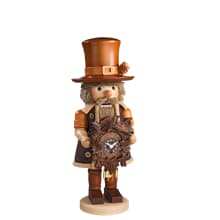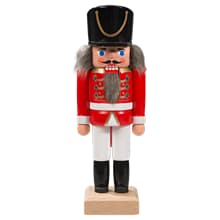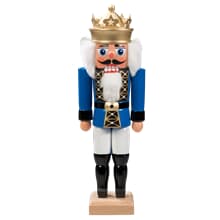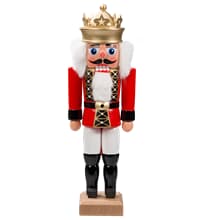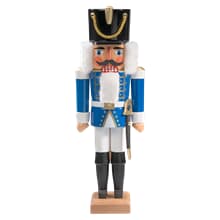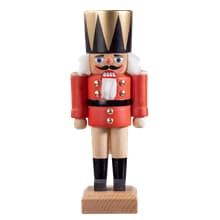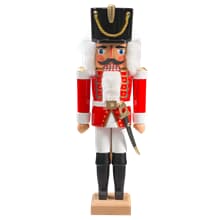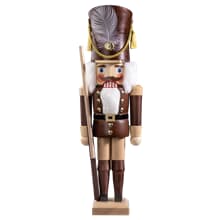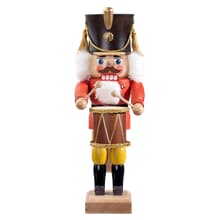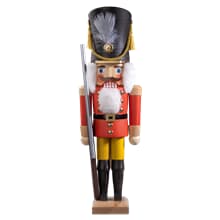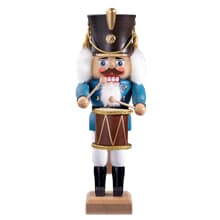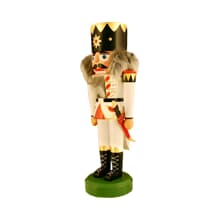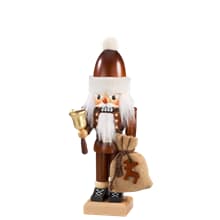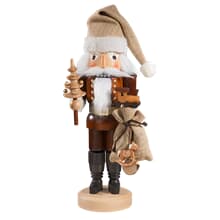Nutcracker from the Erzgebirge - Purpose and beauty combined ingeniously in wood art
Very first methods of cracking nuts already resemble the later nutcracker. However, the stone and anvil are not really decorative. The decorative figures from the Erzgebirge are much more versatile. Especially in the Advent and Christmas season they belong like other Erzgebirge folk art in every decorated room.
How the nutcracker got his uniform
The mining of ores from deep rock determined the life of the people in the Erzgebirge for a long time. Despite all the diligence, the weather determined whether the miners had work or had to hold out between the snow and the forests. The forests gave the skilled miners the idea of combining the useful with the playful. In the long Erzgebirge winter, they tinkered with the first nutcrackers as children's toys. After all, they had created a joy for the youngest ones despite their poverty during the unemployed period. Many figures with a similar history of invention are known today in the Erzgebirge folk art. Among them, the nutcracker in the miner's costume is one of the oldest.
The upright posture was accompanied by a stern facial expression since the first nutcrackers. The mouth was a lever and would have served its functional purpose less well in curved form. But posture and facial expression gave the resourceful craftsmen an idea: why not make their opinion known to the authorities without words? The wooden miner quickly changed his costume for the garb of a prince, the uniform of a hussar or that of the local village gendarme. The authorities could do little against this creative expression. The poor people of the area took up the design possibilities.
The modern nutcracker from the Erzgebirge has many different forms. Classic figures are still king, hussar, soldiers, gendarmes or miner. But the nutcracker of our century now also presents itself with a little belly, chubby cheeks and almost a smile. In addition, there are many variations and variations of classic figures such as a king, gendarme or soldier in fancy colors and robes. Such ideas and motifs as the cozy night watchman, the patient shepherd or even Santa Claus show the change that makes the Erzgebirge folk art even more diverse. International demand has certainly also led to this trend.
Arts and crafts from the Erzgebirge: Humorous and pragmatic
At the time when the first nutcrackers were made, only the powerful of their time could afford tongs for cracking nuts. Well-paid merchants sat at home with their cracking tools made of iron - the very material that the inventors of the nutcracker painstakingly mined from the depths of the Ore Mountains. Today, Erzgebirge folk art is a testament to how literal hardship for a living makes one inventive. Accordingly, modern artisans of the region continue to invent creations that, in addition to their function, also give pleasure.
Machine production of the coveted kitchen helper and children's toy, often depicted as a king or soldier, has now also found its way into the Erzgebirge. The more than 60 parts of a classic nutcracker are prepared by programming and only assembled on the assembly line. But the manufactories of wooden toys continue to hold their own due to great international demand. Wood for the nutcracker remains the preferred material for both variants - manual production and mass production. Only a few small foam models made of plastic have been able to establish themselves internationally despite the strong demand to date. Collectors swear by the intricate handwork and wooden art. Even among families of emigrants, the little faithful helper has established itself. Only it no longer has its simple function for cracking nuts all over the world.
Originally, at least the mouth could be moved manually with the help of the lever in the neck. Some game types also allowed a kind of marching step with leg stretching or arm changes. Although all these playful extras now receive little attention, nutcrackers traditionally still consist of their approximately 60 individual parts. Not the function, but the love of detail is in it symbol of lived erzgebirgische folk art.
Erzgebirge folk art and modern myths about the current production
When industrialization began its triumphant advance, numerous manufacturers sought to produce the nutcracker in a less labor-intensive manner with the same quality. Metals and later plastics were tried out in order to produce the original from the Erzgebirge on the assembly line more cheaply. However, it became apparent that quality requirements such as wear, durability and beauty could not be achieved by such supposed innovations. Quite the contrary: instead of the original 60 or so parts in about 60 work steps, a modern nutcracker now has to be worked on more than 100 times before it can be similarly decorative and useful in the home.
The reason for this lies in the invention time of the strict and at the same time useful Christmas journeyman. Erzgebirge folk art aimed to create things with the least possible effort and the greatest possible utility. The miners carved and planed, their family painted and pasted, and finally the children's toy with added value stood in the home in optimal condition. The myth that you can easily make a real nutcracker out of metal and with machines remains disproved to this day.
The demand for nutcrackers in all kinds of designs has continued unabated from the century of its invention to the present century. The stern guardians serve as figures on a recreated battlefield, as Halma figures of special nostalgic value or as a traditional part of modern Christmas decorations. Wooden versions, whether with mouth tools or simply lovingly recreated for play purposes, remain trendy in the international marketplace.
Superlatives from the Erzgebirge
The manufacturers in the Erzgebirge are justifiably proud of the triumphant progress of their craftsmanship beyond national borders. What once brought children's laughter into poor parlors, nowadays decorates Christmas rooms on many continents thanks to the high-quality wood art. That is why handicraft with all its time-consuming steps remains undisputedly popular alongside many attempts to produce the nutcracker in a similarly authentic way on the assembly line.
Tradition for the Erzgebirge folk art also means the preservation of values in the individual areas. In the regions with the most and most popular arts and crafts workshops, superlatives on individual carving and Christmas themes gradually emerged. The nutcracker literally plays a weighty role in this. As a worthy representative of the old handicrafts, it watches over the entrance in the Nutcracker Museum with a proud height of over ten meters. Could there be nuts to crack in such dimensions? It's possible, because this world's largest representative of his guild works basically like his colleagues in the living room.
The small representatives in the same museum show a nice insight into the variety of ideas of the carvers and turners from the Erzgebirge. More than 5,000 specimens allow visitors to get an idea of the wealth of ideas, especially in the design of uniforms. In droves, unique pieces from several ages from the beginning of Erzgebirge folk art are gathered.
Nutcracker as inspiration for other fields of art
He may look no matter how sternly across the table: Artists were inspired by its unique shape long ago. E.T.A. Hofmann at the latest made the tool and children's toy suitable for the stage. The narrator turned the gift into a hero. He, in turn, later made it to ever new fame in the world of television. In the meantime, there are several cartoons, animated films and even fantasy films starring the wooden journeyman from the Ore Mountains.
Erzgebirge folk art is even represented in ballet with the Nutcracker as an artistic hero. P.I. Tchaikovsky dedicated the Christmas heroic story to his own children. To this day, the Dream of Clara and the Victory of the Nutcracker are danced and intoned on great stages all over the world. It is possible that such artistic variations are one reason for the unbroken popularity of the wooden kitchen helper and children's toy from the Ore Mountains to this day.
Conclusion:
It is impossible to imagine the decorations for Advent without the nutcracker from the Erzgebirge. It cracks nuts, looks more or less stern and has established itself as a symbol of the winter and Christmas season on several continents. In addition to today's often mechanized production and examples made of metal or plastic, the wooden manufactory productions continue to assert themselves as a permanent trend.




